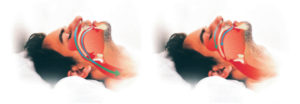
OSAS is an emerging public health problem. Early diagnosis in adults with comorbidities is the gold standard to avoid complications caused by a late diagnosis. The aim of the study, part of the SLeeP@SA project, was to identify within a population with dysmetabolic comorbidities the association of occlusal clinical signs, defined by orthodontic parameters, and of the anthropometric phenotype, with the severity of OSAS.
Materials and methods: A dedicated questionnaire containing questions regarding the presence of deep bite, augmented overjet, partial edentulism, and bruxism was completed by clinic staff. OSAS was evaluated using an unattended home PSG device, which recorded the AHI value. BMI and neck circumference were also measured. The Kolmogorov-Smirnov test was performed to evaluate the association of the AHI with occlusal clinical signs. The significance was set at p ≤ 0.05. The association of AHI with BMI and neck circumference was evaluated with the Pearson correlation coefficient.
Results: In total, 199 subjects were evaluated. No statistically significant association between occlusal parameters and AHI was found, while the AHI showed a positive correlation with BMI and neck circumference. The neck circumference seemed to be a better clinical predictor for OSAS severity than BMI, especially for females.
Conclusions: These results highlight how the orthodontic clinical data alone are not sufficient to establish an association between occlusal anomalies and OSAS severity, but further investigation involving a specialist orthodontic diagnosis is necessary.
Keywords: OSAS; apnea; breathing; comorbidities; obstructive sleep; sleep disorder.
Qui è possibile consultare l’articolo


Commenti recenti